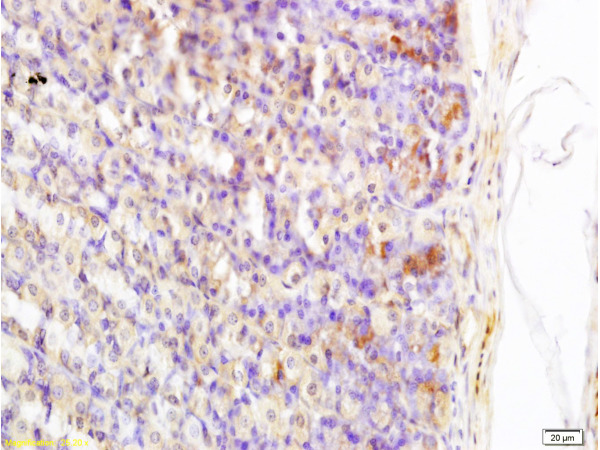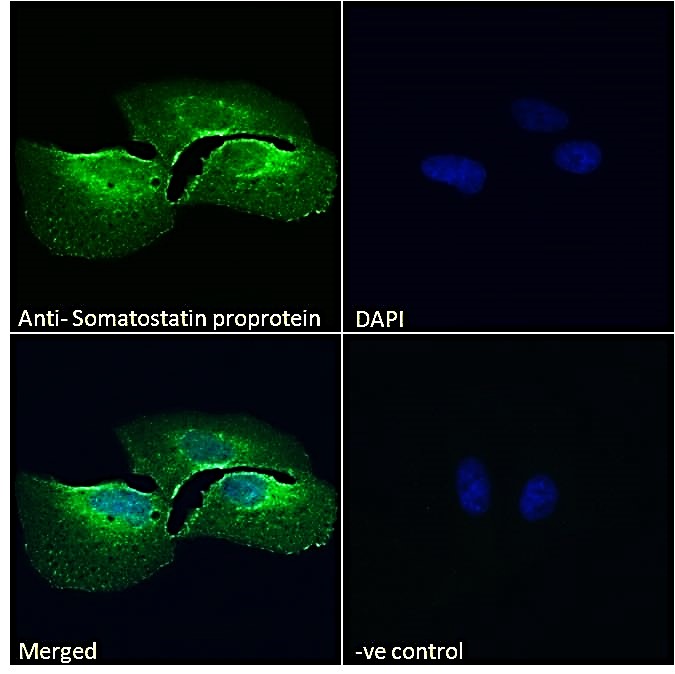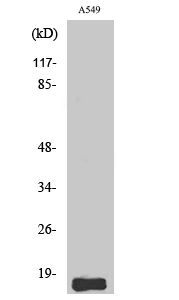Somatostatin antibody [SOM-018]
GTX71935
ApplicationsImmunoFluorescence, ImmunoCytoChemistry, ImmunoHistoChemistry, ImmunoHistoChemistry Frozen, ImmunoHistoChemistry Paraffin
Product group Antibodies
TargetSST
Overview
- SupplierGeneTex
- Product NameSomatostatin antibody [SOM-018]
- Delivery Days Customer9
- Application Supplier NoteRecommended Starting Dilutions:For ICC/IF: Use at a dilution of 1:25-1:100For IHC-Fr: Use at a dilution of 1:25-1:100For IHC-P: Use at a dilution of 1:25-1:100Not yet tested in other applications. Optimal dilutions should be determined experimentally by the researcher.
- ApplicationsImmunoFluorescence, ImmunoCytoChemistry, ImmunoHistoChemistry, ImmunoHistoChemistry Frozen, ImmunoHistoChemistry Paraffin
- CertificationResearch Use Only
- ClonalityMonoclonal
- Clone IDSOM-018
- Concentration0.14 mg/ml
- ConjugateUnconjugated
- Gene ID6750
- Target nameSST
- Target descriptionsomatostatin
- Target synonymsSMST, SST1, somatostatin, growth hormone release-inhibiting factor, prepro-somatostatin, somatostatin-14, somatostatin-28
- HostMouse
- IsotypeIgG1
- Protein IDP61278
- Protein NameSomatostatin
- Scientific DescriptionThe hormone somatostatin has active 14 aa and 28 aa forms that are produced by alternate cleavage of the single preproprotein encoded by this gene. Somatostatin is expressed throughout the body and inhibits the release of numerous secondary hormones by binding to high-affinity G-protein-coupled somatostatin receptors. This hormone is an important regulator of the endocrine system through its interactions with pituitary growth hormone, thyroid stimulating hormone, and most hormones of the gastrointestinal tract. Somatostatin also affects rates of neurotransmission in the central nervous system and proliferation of both normal and tumorigenic cells. [provided by RefSeq, Jul 2008]
- Storage Instruction2°C to 8°C
- UNSPSC12352203
References
- Kondabolu K, Doig NM, Ayeko O, et al. A Selective Projection from the Subthalamic Nucleus to Parvalbumin-Expressing Interneurons of the Striatum. eNeuro. 2023,10(7):pii: ENEURO.0417-21.2023. doi: 10.1523/ENEURO.0417-21.2023.Read this paper
- Galer EL, Huang R, Madhavan M, et al. Cervical Epidural Electrical Stimulation Increases Respiratory Activity through Somatostatin-Expressing Neurons in the Dorsal Cervical Spinal Cord in Rats. J Neurosci. 2023,43(3):419-432. doi: 10.1523/JNEUROSCI.1958-21.2022Read this paper
- Huang DF, Lee CY, Chou MY, et al. Neuronal splicing regulator RBFOX3 mediates seizures via regulating Vamp1 expression preferentially in NPY-expressing GABAergic neurons. Proc Natl Acad Sci U S A. 2022,119(33):e2203632119. doi: 10.1073/pnas.2203632119Read this paper
- Lukacs IP, Francavilla R, Field M, et al. Differential effects of group III metabotropic glutamate receptors on spontaneous inhibitory synaptic currents in spine-innervating double bouquet and parvalbumin-expressing dendrite-targeting GABAergic interneurons in human neocortex. Cereb Cortex. 2023,33(5):2101-2142. doi: 10.1093/cercor/bhac195Read this paper
- Domi E, Xu L, Toivainen S, et al. A neural substrate of compulsive alcohol use. Sci Adv. 2021,7(34). doi: 10.1126/sciadv.abg9045Read this paper
- Sato K, Hayashi H, Shimotai Y, et al. TMPRSS2 Activates Hemagglutinin-Esterase Glycoprotein of Influenza C Virus. J Virol. 2021,95(21):e0129621. doi: 10.1128/JVI.01296-21Read this paper
- Liu J, Kashima T, Morikawa S, et al. Molecular Characterization of Superficial Layers of the Presubiculum During Development. Front Neuroanat. 2021,15:662724. doi: 10.3389/fnana.2021.662724Read this paper
- Yamamoto T, Sasaguri K, Mizumoto N, et al. The Chemokine CXCL14-like Immunoreactivity Co-exists with Somatostatin, but not NPY in the Rat Dorsal Horn and Has Intimate Association with GABAergic Neurons in the Lateral Spinal Nucleus. Acta Histochem Cytochem. 2020,53(5):121-129. doi: 10.1267/ahc.20-00004Read this paper
- Sato M, Mizuta K, Islam T, et al. Distinct Mechanisms of Over-Representation of Landmarks and Rewards in the Hippocampus. Cell Rep. 2020,32(1):107864. doi: 10.1016/j.celrep.2020.107864Read this paper
- Zhu JW, Zou MM, Li YF, et al. Absence of TRIM32 Leads to Reduced GABAergic Interneuron Generation and Autism-like Behaviors in Mice via Suppressing mTOR Signaling. Cereb Cortex. 2020,30(5):3240-3258. doi: 10.1093/cercor/bhz306Read this paper






